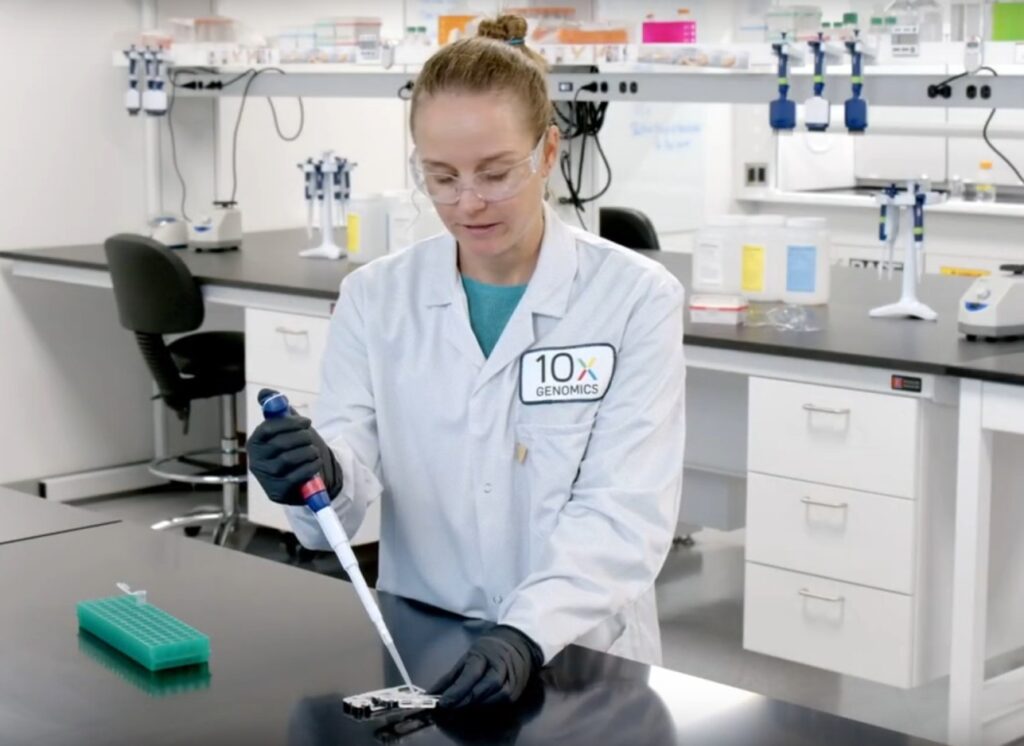After launching numerous new products for its three platform technologies throughout 2024, 10x Genomics is taking a pause from rollouts, focusing instead on marketing its single cell, spatial, and in situ offerings—especially to biopharma business customers, where the company sees opportunity for sharp growth.
10x’s co-founder and CEO Serge Saxonov, PhD, says the company’s priorities for 2025 include promoting the new products it launched in 2024, stepping up customer support, and moving forward with a renewed sales effort following a reorganization that the company blamed in part for lower-than-expected results.
During 2024, 10x brought to market several new features for its Xenium In Situ single-cell spatial imaging platform and commercially launched Visium HD (a new version of its Visium Spatial Gene Expression product), enabling researchers to measure the whole transcriptome from formalin-fixed paraffin-embedded tissue sections at single-cell resolution. Visium HD can detect 11 million features in a continuous grid pattern of 2 μm squares, vs. 5,000 features detectable in a hexagonal arrangement of 55 μm spots for the earlier version.
10x also launched two new products from its Chromium single-cell analysis line aimed at expanding its customer base by emphasizing reduced costs as well as top-tier performance for both larger- and smaller-scale projects. At the larger-scale end, 10x has rolled out its GEM-X Flex Gene Expression offering, a next-generation successor to its Chromium Flex single-cell gene expression technology that is designed to lower customer costs per project, per experiment, per sample—and even per cell, where the company promises to deliver “single cell for a single cent.”
For smaller-scale analyses, 10x has introduced its GEM-X Universal Multiplex product, intended for customers with samples in the thousands of cells that are looking to run more cost-effective single cell studies. 10x also began shipping Chromium Xo, designed as a budget-friendly instrument for uses conducting routine, high-performance single cell analysis.
“All of these were revolutionary product sets, each in its own way, and we did all of them together in one year. It created challenges because customers had to certainly value them and decide whether they want to transition their projects and their studies into these new products,” Saxonov told GEN Edge in an interview during the recent 43rd Annual J.P. Morgan Healthcare Conference, held in San Francisco. “That’s a challenge. That’s a negative. The positive is that the products have been received was really, really great feedback from customers, and have put us in really good position going forward now for the future, like great performance—all kinds of benefits across the board.”
“You have to let customers digest all this new goodness,” Saxonov added. “And we’re going to make sure we take the time to support our customers in all the new experiments and all the new science that they’re doing.”
Customer need, legal challenge
Saxonov said 10x’s focus on lowering Chromium’s cost per cell is a response to customer need—and not, he asserted, to criticism directed against the company that it was trying to monopolize single cell analysis and the broader spatial biology field. Last year, 10x denied it was acting to squelch competition by aggressively litigating potential infringement of its patents, as alleged by the then-CEO of rival NanoString—since acquired by Bruker, where it anchors that company’s new spatial biology division—and a group of academic researchers in a GEN commentary.
10x rang out 2024 with a legal victory, as the U.S. District Court for the District of Delaware in late December upheld the approximately $31.6 million award assessed in 2023 against NanoString in a patent infringement case filed by 10x. The court sided with 10x in ruling that its patents were infringed when NanoString launched its GeoMx® Digital Spatial Profiler products. The court also granted 10x’s request for an injunction against GeoMx products in the U.S.—but declined 10x’s request for enhanced damages and attorneys’ fees.
Saxonov noted that the injunction includes a “carve out” allowing NanoString to sell consumables to the installed base of GeoMx customers that existed as of the court’s November 2023 verdict, in order for them to complete their ongoing research.
Bruker has responded by seeking a stay of the injunction, stating it will pursue an appeal with the U.S. Court of Appeals for the Federal Circuit, and publicly disagreeing with the District Court’s decision.
“We remain steadfast in our view that the patents that were licensed by 10x and asserted against us are invalid and describe a fundamentally different method than what is used by the GeoMx system,” Todd Garland, president of the Bruker Spatial Biology division, said in a statement. “We strongly believe that we should be vindicated on appeal.”
The legal victory for 10x will strengthen its U.S. competitive position and could generate a potential windfall for the company of $40 million or more, Jefferies analyst Tycho Peterson estimated last month. He acknowledged the outcome was a “negative headline” for Bruker but could ultimately benefit the company by lowering what it has had to spend on legal expenses related to GeoMx by $10 million to $20 million a year.
“We see incremental upside [for 10x] given the market removal of a well-funded competitor and supplemental damages that were not previously baked into assumptions,” Peterson wrote in a research note. “Furthermore, the company recognized ~$30M of legal expenses since the start of 2023, which should decline in the coming quarters (with potential recoup by enforcing [Bruker’s] payment of attorney’s fees) and help the profitability profile moving forward.”
Seeking better results
10x hopes customers will perceive the benefits of its newer launches enough to generate better results in 2025. The company has released preliminary, unaudited select fourth-quarter and full-year 2024 results showing revenue of approximately $165 million for Q4—up 9% from the third quarter but 10% down from the final three months of 2023. For all of 2024, 10x generated $610.8 million in revenue, down 1% from the previous year—but 1% above the high end of its 2024 revenue guidance to investors of between $595 million and $605 million.
10x has blamed the all but flat year-over-year results on several factors, citing macroeconomic uncertainty and resulting lower customer budgets for capital expenditures or “capex” on equipment purchases. Those reduced budgets, according to the company, explain why 10x’s instrument revenue during Q4 fell 37% year-over-year to approximately $24.4 million. For all of 2024, 10x’s $92.7 million in instrument revenue tumbled 25% from 2023.
“We’ve seen a lot more caution and conservatism in terms of how people were spending their funds on instrumentation,” Saxonov said. “That was the story of last year. It started weak and it was getting weaker throughout the year. And I think that’s probably the biggest reason for the instrument challenges we faced last year.”
Saxonov is quick to add that 10x’s fourth-quarter instrument revenue rose 28% quarter over quarter vs. Q3. Chromium remains 10x’s flagship product line, accounting for more than 5,800 of the over 7,000 total instruments sold by 10x, compared with over 800 Visium instruments and over 400 Xenium instruments. In terms of instrument revenue, Chromium generated approximately $10.9 million, while Visium and Xenium racked up a combined $13.4 million.
“It was obviously challenging last year. It’s unlikely to get worse. We’re also not assuming it’s going to get better,” Saxonov said. “Our best, best view, most likely is that roughly it’s going to be similar going forward.”
Sales force reorganization
Another factor 10x has cited for its revenue declines is a reorganization of its sales force, which the company says was needed to better market its broader menu of products and services, and thus better serve not only more customers but more types of customers. “We needed to make sure we have the sales structure that can support all these new products and new customers and customer types,” Saxonov said.
10x created several new teams, one of which focuses on selling its more sophisticated instrumentation, such as Xenium.
“We also created a team that was going to be focused on emerging new accounts and new customers that are coming in, just starting to do single cells and spatial biology, to keep nurturing them so they can become bigger and bigger customers,” Saxonov explained. “We separately also created a team that is focused on existing accounts—maintaining them, helping them scale up their usage, making their usage more routine, and again not being distracted by the new customer acquisition or trying to sell big instruments.”
Finally, Saxonov said, 10x created a separately structured team focused on marketing to biopharma companies.
“Right now, biopharma is only about 15 to 20% of our business. But we believe based on our market analysis and conversations with customers that it should be more like 50%. There’s a lot of potential for us to grow,” Saxonov asserted. “That’s a very different sale than selling into academia. It requires a different set of skills, different set of relationships, different approach to sales. And splitting it up from the rest [of the teams] is the kind of thing that we expect will help us reaccelerate our biopharma sales, where we have a huge opportunity which we have not really penetrated too much, to a great extent.”
Ultimately, Saxonov said, the reorganization will benefit 10x by helping it more efficiently allocate commercial resources to reach more customers, tailor its marketing to their expertise and needs, and position the company for longer-term growth: “It will allow our people to become really, really excellent at their goals and will allow them to focus and not be distracted. So I think overall, that’ll really help us to drive revenue growth.”



